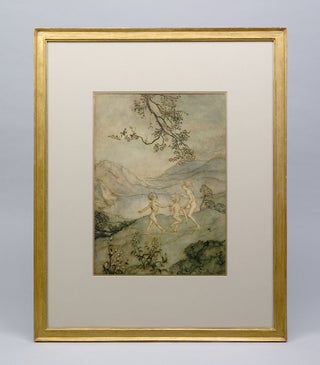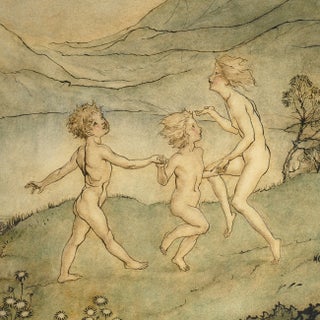“Paradise of Children, The”
[n.p.]: , 1922. Item #00625
A Superb Original Arthur Rackham Watercolor Drawing
for Nathaniel Hawthorne’s “A Wonder Book”
RACKHAM, Arthur (1867-1939). “The Paradise of Children.” London: 1922. Original pen-and-ink and watercolor drawing for the tinted line drawing illustrating “The Paradise of Children” (“Pandora’s Box”) in Nathaniel Hawthorne’s A Wonder Book (London: [n.d., 1922]). Signed and dated at lower right. Image size: 15 x 11 inches (381 x 279 mm.). Matted, framed, and glazed.
“Long, long ago, when this old world was in its tender infancy, there was a child, who never had either a father or a mother; and, that he might not be lonely, another child, fatherless and motherless like himself, was sent from a far country, to live with him, and be his playfellow and helpmate. Her name was Pandora.
The first thing that Pandora saw, when she entered the cottage where Epimetheus dwelt, was a great box. And almost the first question which she put to him, after crossing the threshold, was this,—
‘Epimetheus, what have you in that box?’
‘My dear little Pandora,’ answered Epimetheus, ‘That is a secret, and you must be kind enough not to ask any questions about it. The box was left here to be kept safely, and I do not myself know what it contains.’
‘But who gave it to you?’ asked Pandora. ‘And where did it come from?’
‘That is a secret too,’ replied Epimetheus.
‘How provoking!’ exclaimed Pandora, pouting her lip. ‘I wish the great ugly box were out of the way!’
‘Oh come, don’t think of it anymore” cried Epimetheus. “Let us run out of doors, and have some nice play with the other children.’
It is thousands of years since Epimetheus and Pandora were alive; and the world, nowadays, is a very different sort of thing from what it was in their time. Then, everybody was a child. There needed no fathers and mothers to take care of the children; because there was no danger, nor trouble of any kind, and no clothes to be mended, and there was always plenty to eat and drink. Whenever a child wanted his dinner, he found it growing on a tree; and, if he looked at the tree in the morning, he could see the expanding blossom of that night’s supper; or, at eventide, he saw the tender bud of tomorrow’s breakfast. It was a very pleasant life indeed. No labor to be done, no tasks to be studied; nothing but sports and dances, and sweet voices of children talking, or caroling like birds, or gushing out in merry laughter, throughout the livelong day.”
This charming watercolor drawing depicts life as it was before Pandora opened the “great ugly box”— a wonderfully gentle pastoral scene, with a group of three naked children dancing merrily, without a care in the world, with “the expanding blossoms of that night’s supper” hanging heavily on the tree above their heads and “the tender bud of tomorrow’s breakfast” growing on the plants in the foreground.
“The moment one opens Hawthorne’s Wonder Book one becomes aware of the rounding and softening of form in Rackham’s work. The modern Pandora of Hawthorne opens her box for the world in 1921, and she is a very living young girl, with breasts just beginning to swell, indicating that Rackham was aware of the undertones of this story which is being retold with every lifetime. In ‘The Paradise of Children’ from the same text the children are drawn in line, but the washes of colour give them a rotundity of form and a very human life. The point which Rackham is making, surely, is that these are real children, a real Pandora, and not some dream from fairy land” (Fred Gettings, Arthur Rackham, p. 141).
Price: $38,500.00

 I have been in the rare and antiquarian book business for over forty years; my family has been in the rare books business since 1876. Rare books are in my blood.
I have been in the rare and antiquarian book business for over forty years; my family has been in the rare books business since 1876. Rare books are in my blood.


